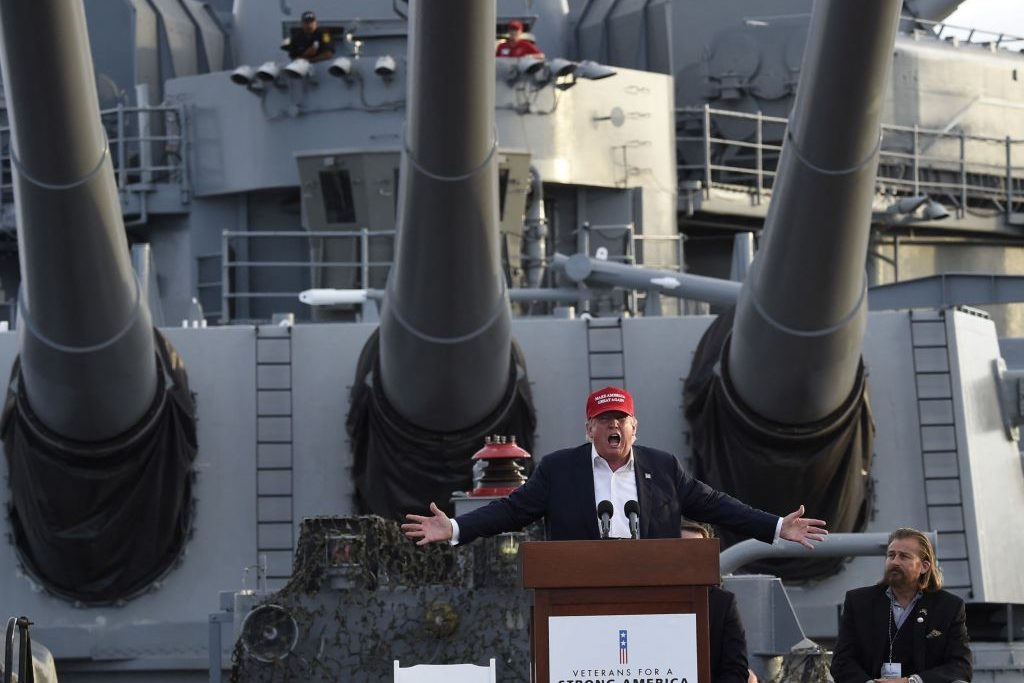The US Navy retired its last battleship 19 years ago, the grand warship’s devastating firepower deemed surplus to requirements in the new war on terror. But the era of Great Power conflict has now returned with storm clouds gathering between the US and China. And with them the old warhorse bristling with guns, the battleship, is facing a call back to action.
President Trump has said the battleship will come back as the centerpiece of his new Golden Fleet – a cadre of warships designed to equip our navy to face the challenges of the future, not the past.
In a speech to the nation’s top military brass, Trump said:
“I think we should maybe start thinking about battleships, by the way. You know, we have – Secretary of the Navy came to me – because I look at the Iowa out in California and I look at different ships in the old pictures… Some people would say, no, that’s old technology. I don’t know. I don’t think it’s old technology when you look at those guns, but it’s something we’re actually considering, the concept of battleship, nice six-inch size, solid steel, not aluminum, aluminum that melts if it looks at a missile coming at it… Now those ships, they don’t make them that way anymore… But I tell you, it’s something we’re seriously considering.”
America hasn’t built a new battleship since World War Two. The warship class fell to the wayside because submarines and aircraft carriers can project power further, and nuclear weapons became a focus. The last American battleships built were modernized for use in the First Gulf War in 1991 and were mainly shelled Iraqi shore positions.
The “Iowa” that Trump referenced in his speech is the eponymous battleship, built in 1944 and finally retired in 2006 after on-and-off service for decades, including in Operation Desert Storm. It now sits as a museum ship in Los Angeles, drawing crowds who wish to see the last of the iconic warships that captured the public imagination for generations. That fascination with the battleship has led to films, board games and plenty of influence on popular culture. And it may now augur the return of the ship class, given the president’s powerful interest in the matter.
Battleships were always about bringing to bear as much destructive long-range firepower as possible, while retaining the ability to strike back if hit by the enemy. And it’s those qualities that the US Navy believes it needs again. Beijing has the ability to block access to the Taiwan Strait for American surface ships with longer-range missiles. But if America possessed battleships with similar ranged missiles it could make a difference in defending the island. These long-range munitions have been effective in the Ukraine War and may be similarly effective in the looming conflict in Asia, especially if they are based on maneuverable warships.
American warships today are generally lightly armored and rely on avoiding or countering enemy fire, but that may not be possible in a more evenly matched conflict. Battleships are meant to strike hard, yet survive by absorbing enemy firepower. Executing retaliatory strikes after taking enemy hits gives it an advantage over other modern warships.
And modern battleships could be built to field more advanced weapons systems, whether that is the long-discussed railgun – which the Japanese are heavily testing – or swarms of autonomous drones providing cover and extending range. All of this would be powered by the same nuclear reactors that make our aircraft carriers and submarines the most advanced in the world.
But creating a brand-new ship design would be incredibly time-consuming and expensive. America already struggles to build and maintain the fleet that we have, so adding a novel warship class would tax that maritime infrastructure to its limit. We would need to build several additional shipyards to accommodate the construction of the “Golden Fleet,” but these new facilities would possibly be more useful producing already-existing, combat-ready ships and submarines. Even if those facilities were available immediately, the design, construction and testing process for the new battleships would take years, if not a decade. Any claims as to when these ships could roll off the line would likely be a significant underestimate.
The China challenge is not in the far future. It is here in the present. America’s limited resources should, in the minds of the battleship skeptics, be ruthlessly prioritized to build as many useful, proven ships as quickly as possible. China’s navy is larger than our own and we need to play catch-up. If we decide to innovate a novel design, we will only fall further behind Beijing at a time in which we cannot afford to. The American people are only so willing to incur more debt and finance larger military budgets, even in the face of a powerful adversary. Prioritization is necessary to make the most of our constraints and still achieve victory. And achieving that victory is a must.
America is historically a maritime power built around a mighty naval force that defends our interests and commerce abroad. The past two decades of land-based imperial policing actions in Western Asia have abstracted us from that storied history and downplayed our innate national advantages. Focusing on our naval mission, especially in an era of Great Power conflict, is crucial. It, alongside our aerospace dominance, will be the defining military factor in any American success over the coming decades. The battleship may or may not be a part of that success, but the conversation that the idea has sparked is a prerequisite for achieving it.
Trump plays battleships
The President says the battleship will return as the centerpiece of his new Golden Fleet

Donald Trump gives speech aboard the World War Two Battleship USS Iowa, September 15, 2015, in San Pedro, California (Getty)
The US Navy retired its last battleship 19 years ago, the grand warship’s devastating firepower deemed surplus to requirements in the new war on terror. But the era of Great Power conflict has now returned with storm clouds gathering between the US and China. And with them the old warhorse bristling with guns, the battleship, is facing a call back to action. President Trump has said the battleship will come back as the centerpiece of his new Golden Fleet – a cadre of warships designed to equip our navy to face the challenges of the…

























Leave a Reply